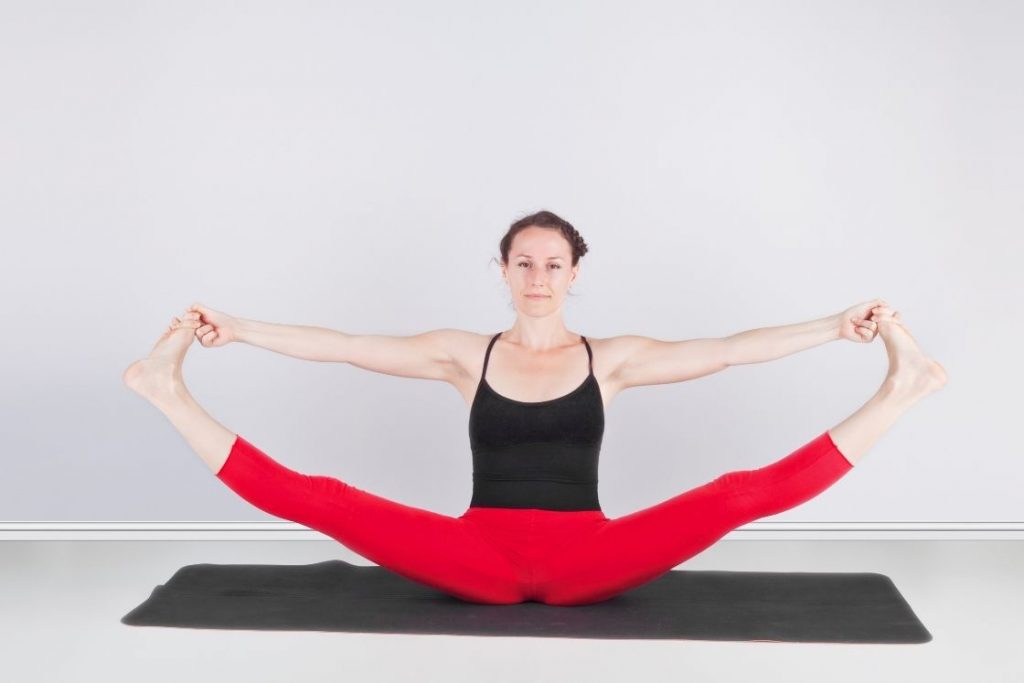
| Sanskrit (Pronunciation) | Urdhva Upavistha Konasana (Uerd-vah oo-pah-veest-ah kone-ah-sah-nah) |
| Common | Upward Facing Wide-Angle Seated Pose, Spinal Column Pose, Merudandasana |
| Type | Seated pose |
| Level | Intermediate |
| Stretches | Hamstrings, thighs, triceps-biceps, hip flexors |
| Strengthens | Core, calves, and shoulders |
Urdhva Upavistha Konasana is an intermediate seated pose where you need to balance your body on sitting bones while actively stretching your arms and legs upwards.
In Sanskrit urdhva means upright or upwards, upavistha means sitting or seated, kon means angle and asana means pose. Thus, in English, this pose is translated to Upright Seated Angle Pose. Sometimes it’s also translated as Upward-Facing Wide-Angle Seated Pose.
Your spine plays an important role in this pose, with its active engagement in maintaining balance as well as keeping your back upright. As a result, Urdhva Upavistha Konasana is also called Spinal Column Pose.
Holding urdhva upavistha konasana for an extended duration allows energy flows upwards from the base of the spine (Muladhara or Root Chakra) to the crown of the head (Sahasrara or Crown Chakra). It is a robust and energetic pose that promotes energy in the body once you put consciousness to it.
Through practicing this pose your balance is improved, the abs, spine, and legs are strengthened and toned. Also, it massages the spinal column and stimulates the digestive internal organs.
Preparatory Poses
- Butterfly Pose (Baddha Konasana)
- Wide-angled Seated Forward Bend (Upavistha Konasana)
- Head-to-knee Pose (Janu Sirsasana)
- Wide-Legged Standing Forward Bend (Prasarita Padottanasana)
- Garland Pose (Malasana)
How to Do?
Follow these steps to perform Urdhva Upavistha Konasana.
- Start with sitting in Dandasana, back straight and legs stretched in front of you.
- Bring your feet towards you by externally rotating your hips and joining them at the soles. It’s baddha konasana.
- Hook your first two fingers around the big toe.
- Lean back slightly and start extending your legs straight upwards. Separate them sideways as far as you can.
- Your toes should be pointing upwards and your knees should be straight. Your legs will be at an angle from the torso.
- Pull up your kneecaps and activate your quads to keep the legs straight.
- Lift your chest upward and keep your neck neutral. Keep your gaze upwards, at a fixed point, to align the neck.
- Rolling your shoulders back helps to keep your spine straight, erect, and long. Engage your core and tailbone for balance.
Hold this pose for 3-5 breaths. If you’re comfortable enough to hold it more, be there for 15 long breaths.
To come out of the pose, gently bring down your legs by bending them at the knees and back to the original position.
Benefits of Urdhva Upavistha Konasana
Urdhva upavistha konasana strengthens the core, thighs, and calves by integrating them into the movement. It improves the posture through spinal alignment and strengthens the hips. It also helps in toning the muscles of the legs, arms, shoulders, core, and upper belly along with the lower and upper body.
Keeping the above in mind, here are some unique benefits of urdhva upavistha konasana:
- It improves balance and posture by lengthening the spine.
- It stretches the hamstring muscles as well as keeps the hip bone in alignment.
- This pose opens up the hips and groin, allowing for more range of motion.
- It’s a wonderful chest opener pose. It encourages the diaphragm to expand more with each breath, increases breath awareness.
- It stimulates the abdominal organs, which helps to relieve constipation.
- Holding the pose for a prolonged period of time strengthens the pelvic floor.
- The pose also helps to relieve minor sciatica symptoms by opening the hips and extending the hamstrings.
- Regular practice will stretch and release any stiffness in the leg muscles, further keeping the lower body light and strong.
- The stretching of the leg muscles aids in the release of stiffness in the waist, hips, and pelvis, as well as the treatment of any back problems.
- With increased awareness and consciousness, this pose transforms into a dynamic and energetic pose that increases energy in the body.
- Because you must focus on keeping everything active to be balanced, the Upright Seated Angle can help increase your concentration.
Beginner’s Tips
Balancing and stretching legs straight are common problems beginners face in upright seated angle pose. Here are some tips to overcome this.
- As a beginner, you may struggle to maintain balance on sit bones and end up hurting your lower back in this position. Place a folded blanket or towel to elevate your hips level which provides more support and padding for your sitting bones.
- Beginners can also take wall support to maintain balance in this pose.
- If you have difficulty straightening your legs, then slightly bent your legs at the knees and gradually straighten them out.
- Rotate your hips externally before coming into baddha konasana otherwise, knees may face straining.
- You can also use a strap by looping it around the ball of the feet if you have stiff shoulders.
Modifications
Half upright seated angle pose – To enhance your strength, stability, and balance, you can start by bringing only one leg up instead of both. For the leg that you are going to raise first, keep the knee bent slightly to gain some stability before straightening out the leg entirely.
Precautions
Avoid practicing upright seated angle pose in the following conditions:
- Hamstring or groin pull or tear
- Lower-back injury
- Hernia, Slip disc
- Sciatica
- Recent surgery or injury in the lower back, spine, or knee
- Issues in the neck, shoulder, hip, chest, elbows
- You are pregnant or menstruating
If you’re a patient with blood pressure or have a condition that can impact your breath, proceed to perform this pose with extreme caution.
- Before doing this pose, ensure your hamstrings and core are thoroughly warmed up.
- To prevent hunching or rolling your shoulders forward, hold your spine erect throughout the position.
- Make sure there’s adequate room around you should you lose your balance and fall forward or backwards.
Follow-up Poses
- Boat Pose (Navasana)
- Wide-angled Seated Forward Bend (Upavistha Konasana)
- Wide-Legged Standing Forward Bend (Prasarita Padottanasana)
- Hand-to-Big Toe Pose (Utthita Hasta Padangusthasana)
Conclusion
Urdhva Upavistha Konasana is a demanding asana that needs flexibility, core strength, balance, and willpower. This pose allows the spine, hamstrings, and thighs to stretch while strengthening the core, legs, calves, and shoulders. It provides significant physical benefits once perfected.
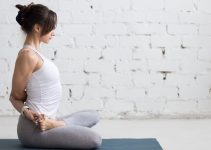
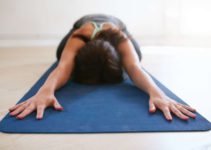
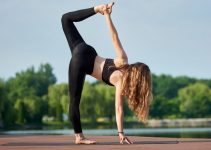
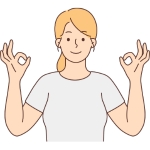
 Oct 27th to 2nd Nov
Oct 27th to 2nd Nov Learn Mudras
Learn Mudras  Deepen Your Practice
Deepen Your Practice  Find Inner Peace
Find Inner Peace